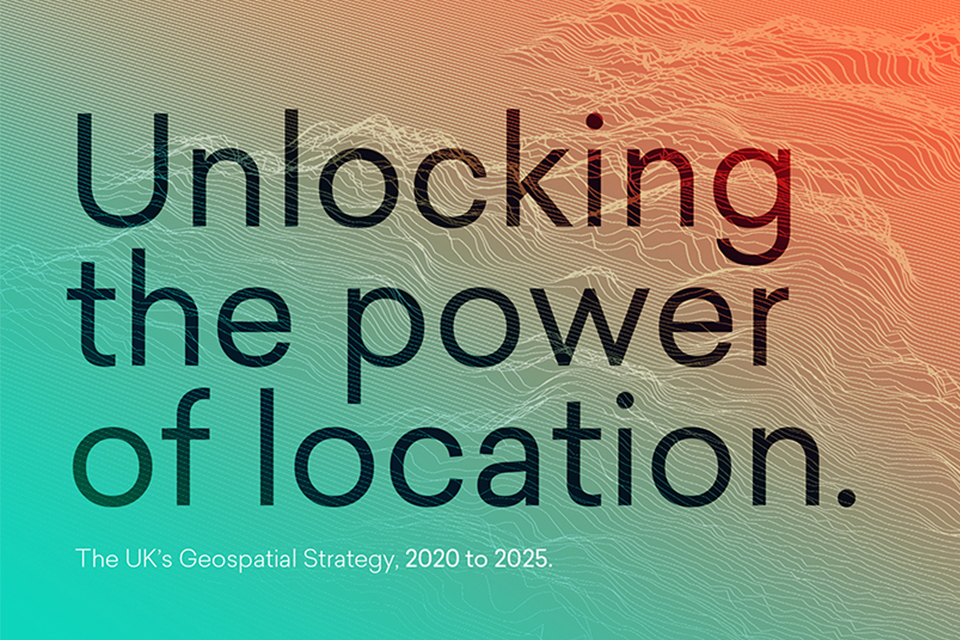The UK Geospatial Strategy 2020-2025

The keenly awaited Geospatial Strategy was published by the UK Government mid June. The strategy sets out to coordinate public sector geospatial activity and to “unlock economic, social and environmental value from geospatial data” over the next five years. Key points from the document are that:
- The Geospatial Commission was established in 2018 to unlock location data with the aim of “improving the lives of UK citizens, supporting infrastructure revitalisation, and helping to achieve net zero greenhouse UK emissions by 2030”. Tackling the impact of the COVID-19 pandemic and aiding the economic recovery is included in the publication.
- Six public sector government bodies responsible for geospatial data are identified in the strategy. Operating as the ‘Geo6’, they are the Ordnance Survey, UK Hydrographic Office, British Geological Survey, HM Land Registry, Coal Authority and The Valuation Office.
- The strategy states that by 2025, the UK will have a coherent’ National Location Data Framework’ as the “unifying connector between Things, Systems, People and the Environment”.
- Nine “location data opportunities”, backed up by nine use cases from the built environment to finance and commerce illustrate the importance of location and the benefits that would result by having a better handle on it.
- Six technological trends are considered to underpin these opportunities: “Real-time data, sensor development, AI, cloud and edge computing, connectivity, 5G and visualisation”.
- Four mission statements present the desired outcomes: Promote and safeguard the use of location data; Improve access to better location data; Enhance capabilities, skills and awareness; and Enable innovation.
The ambitions of the Geospatial Strategy are clearly articulated and well intentioned but, from a position of having been involved in the consultation exercise and as a prime user of marine and coastal geospatial data globally, we struggled to find anything new in the Strategy in terms of changes to government policy that would drive and deliver on these aims. Those of us that have spent more than 20 years in the geospatial industry should also be excused of having a feeling of déjà vu. Read on to find out why.
The Strategy includes the realisation of an Underground Assets Register (UAR), which is sorely needed and we welcome. Yet, in 2000, as part of the UK Government’s Digital National Framework (DNF) initiative, creating an UAR was also a key priority. Despite the fanfare, DNF and the UAR failed to gain momentum because the organisations required to produce it i.e. the utility companies, planning authorities and Ordnance Survey had competing drivers and inconsistent needs for the data. Then in 2008, the UK Government’s ‘Place Matters: The Location Strategy for the United Kingdom’, launched by Sadiq Khan as Parliamentary Under-Secretary of State for Communities and Local Government, also failed to deliver a UAR, for similar reasons. So what’s new? It is difficult to say, perhaps it will be third time lucky, but unless there is recognition of the core issues and fundamental changes in policy then we doubt it.
The Strategy does not mention the need to improve Data Management once! Yet, in our view without fundamental changes in policy, backed up by adequate awareness, training and mentoring in data management skills, and without linking data governance to corporate governance, what is proposed will remain a ‘pipe-dream’. Making data Findable, Accessible, Interoperable, Re-usable (FAIR) is mentioned a lot, but the Strategy is short on detail as to how this will be achieved, something that we in the marine community, through MEDIN for example, have been promoting – and coming up against the same barriers – for over 20 years. In our view, there needs to be a clear distinction between public bodies that maintain geospatial information to support their public task and those for which the maintaining of geospatial information is their public task. The distinction is not apparent in the Geospatial Strategy, but we believe it should be, as it would inform the way the Strategy focuses its efforts. Watch out for a more detailed article on this topic from OceanWise in the coming months.
A third point is the role of the private sector. The Strategy recognises that there have been failures within government engaging with private sector, both in terms of giving only ‘lip service’ to collaboration, and not incentivising the private sector sufficiently to make more of its data available. Notable studies over the years including the ‘MEDIN Data Policy Review’ undertaken in 2010 highlighted the key issues and made recommendations, such as making the supply of marine survey data a condition of a lease or licence to operate, and a need to differentiate between raw data (that should be ‘open’) and data products (that should be left to the private sector in response to customer demand). The Strategy aims to reopen this debate, and promote the success of innovators, which as a company at the forefront of providing marine mapping data products and services globally is something we very much welcome and look forward to being part of the solution.






